Golf Fitness Handicap
The FitGolf® Golf Fitness Handicap is a self-guided assessment, comprised of a series of body movement tests that tell a story about how your body works in the golf swing. It also shows how you might be at risk for an injury from golf. This assessment is a tool that you can use to determine if working with one of our FitGolf® trainers would be of help to you in gaining more comfort in your body movements and improvement in your golf.

“At FitGolf® Performance Centers of San Diego, we believe that your golf swing has to be efficient and safe. Most golfers know their golf handicap, but not their FitGolf® Golf Fitness Handicap. The key to lowering their golf handicap is to have a FitGolf® Golf Fitness Handicap test so that we can see what areas of their body and motion need improvement.”
-Jeremy Klinkhamer, FitGolf® Golf Fitness Specialist
How the Assessment Works
Each test in this assessment is worth a maximum of three points. If you pass the test, your score would be zero; if you fail the test, your score would be three. There are twelve tests in all. If your FitGolf® Golf Fitness Handicap is higher than your Golf Handicap, then FitGolf® Performance Centers staff can improve your body and help you feel and play better. If your Golf Handicap is higher than your FitGolf® Golf Fitness Handicap, then golf lessons from your instructor will have a larger effect on your level of play. That means that your body is working well enough and that there is probably a problem with your technique or skills.
For example, if your FitGolf® Golf Fitness Handicap is 18 and your Golf Handicap is 10, golf fitness training by FitGolf® Performance Centers staff will help you lower your scores, be more consistent, feel better, and prevent injury.
How to Take the Assessment
Below you will see instructions on how to perform all twelve tests in the FitGolf® Golf Fitness Handicap assessment. To find your FitGolf® Golf Fitness Handicap, simply add up the results of each test for your total.
Would you rather one of our Golf Fitness experts walk you through the process? Simply click the button below to purchase this service and one of our FitGolf® trainers will be in contact with you to schedule your assessment.
The FitGolf® Golf Fitness Handicap Assessment
Test #1: Pelvic Tilt
Arch and flex your lower back and pelvis. Is the movement like the pictures? Is it shaky or solid? If your movement looks like the pictures and does not shake, your score is zero. Otherwise, your score is three.

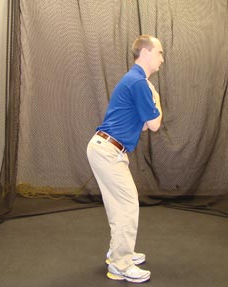
What It Means: How does your lumbar spine and core affect your stability? Does your glute and abdominal control your pelvis and create stability in your swing? If you lose posture during your swing, a challenged pelvic tilt test could be contributing to the loss of posture.
Test #2: Pelvic Rotation
Turn your lower body and keep your upper body perfectly still. If you do this and the lower body rotates, as opposed to sideways motion, you pass and your score is zero. If not, your score is three.


What It Means: Can you rotate your pelvis independently from your upper torso and rib cage? If not, consistent, powerful rotation could be compromised. You might slide or sway, suffer from early hip extension, rotate poorly, lose posture, or chicken wing.
Test #3: Torso Rotation
Turn your upper body and keep your lower body perfectly still. If you do this and the upper body rotates, as opposed to sideways motion, you pass and your score is zero. If not, your score is three.
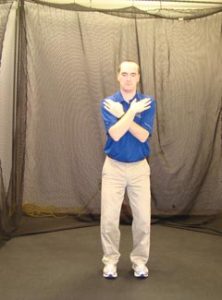
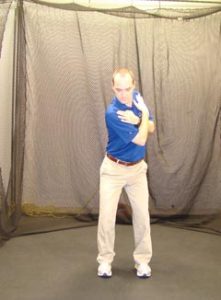
What It Means: Can you rotate your upper torso and rib cage independently from your pelvis? If not, you could have limited mobility in the thoracic spine or poor stability in the pelvic and lower back. This can lead to loss of posture, slides and sways, reverse spine angle (the number one injury-inducing swing fault in golf), and flipping the club.
Test #4: Overhead Deep Squat
Put a golf club over your head and squat. Do your heels come up? Do your hips get below your knees? Does the club get in front of your feet? If any of these happen, your score is three. If your form looks just like the picture below, your score is zero.
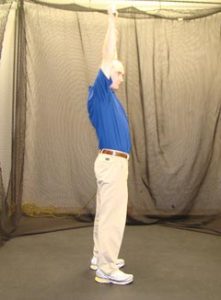
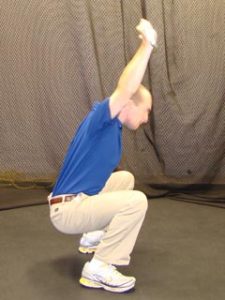
What It Means: This test is telling you about your swing. Data indicates that when a golfer cannot do the Overhead Deep Squat correctly, they will experience early hip extension every time. Ever feel stuck or trapped? Do you have difficulty rotating through impact? That is probably early hip extension in action. Fix the squat form, and your golf swing will improve.
Test #5: Toe Touch
Put your feet together. Bend over and reach for your toes. Your knees need to be kept straight. Do you touch your toes with straight knees? If that is the case, your score is zero. Otherwise, your score is three.

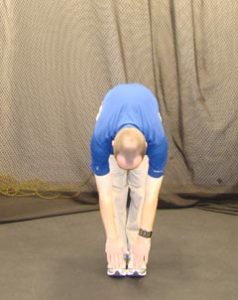
What It Means: Golfers who cannot touch their toes will suffer from loss of spine posture. It could be your hamstrings, your glutes, your abs, or your hip mobility. Failed Toe Touch will lead to inconsistency and challenges with ball striking.
Test #6: 90/90 Shoulder Rotation Test
Start in the position shown on the left picture. Now roll your arms up. If your hands get past your ears, your score is zero. Otherwise, your score is three.

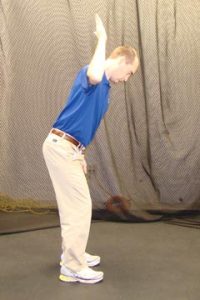
What It Means: Tour players average more than 110 degrees of shoulder external rotation. Golfers who do not have at least 90 degrees of this motion can suffer flying elbows, reverse spine angles, loss of posture, over-the-top motion, and possible shoulder pain. You could also be a slicer because of this shoulder problem.
Test #7: Single Leg Balance
Stand on one leg as shown. Can you make it to 15 seconds with your eyes closed and no wobbles? If you do that on both legs, your score is zero. Otherwise, your score is three.

What It Means: Standing on one leg tests your proprioception systems, balance systems, and core and lower extremity strength and stability, as well as affecting your weight shift.
Test #8: Lat Test
Stand as shown in the left picture below. Now flatten your back and lower your arms. If you keep your back flat, elbows straight, AND touch the wall overhead, your score is zero. Otherwise, your score is three.
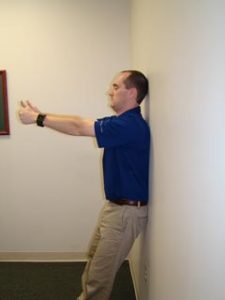

What It Means: This is a test of lat mobility and trunk stability. It is a component of the Overhead Deep Squat. When the lats do not work right, we see a failed Overhead Deep Squat. The Lat Test is linked to loss of posture, early hip extension, and limited shoulder motion.
Test #9: Half Kneeling Rotation
Get into a half-kneeling position. Put the club behind your back. Now turn towards the up knee. How far can you go without moving your knee or losing your balance? If less than 60-70 degrees, your score is three. If 70 degrees or more, your score is zero.

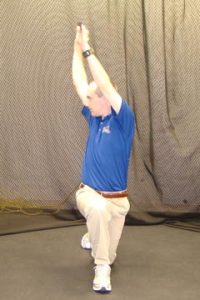
What It Means: This is a test of pelvic stability and trunk mobility. It is a good indicator of how much separation and stability you will have in your swing. This is related to power and consistency.
Test #10: Bridge with Leg Extension
Get into the position on the left. Now pick up your hips, then extend one knee so that you are in the position of the right picture. Do you get a cramp in the back of your thigh? Does your hip fall? Repeat this on the other side. If your hips drop or you get a cramp, your score is three. Otherwise, your score is zero.
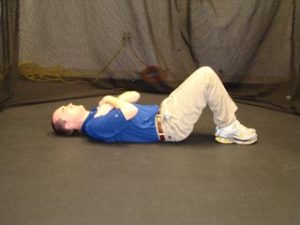
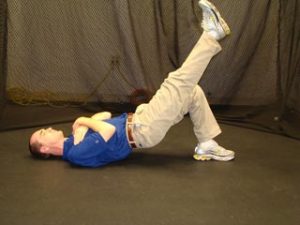
What It Means: This is a test of gluteal control and strength. The glutes are one of the most important muscle groups in the body when it comes to golf. Weakness in the glutes leads to problems in most of the other tests we do.
Test #11: Leg Lowering
Flatten your lower back. Keep it flat and lower one leg without letting go of the lower back release. Do this on both sides. If you can get your leg down and still feel the pressure of the lower back on the floor, your score is zero. Otherwise, your score is three.

What It Means: This is an abdominal stability and strength test. The abdominals are another of the most important muscle groups in the body.
Test #12: Hip Rotation
Stand as pictured on the left. Turn and see if the club is angled to 60 degrees or more, per the picture on the right below. Repeat on the other side. If you do not get past 60 degrees, your score is three. If you do get 60 or more degrees, your score is zero.
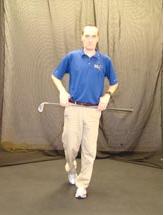
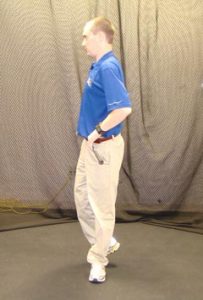
What It Means: Hip joint rotation is critical to hip turn, pelvic and knee stability, and power and consistency in the golf swing. Are your hips helping your swing or not?
What to Do with Your Results
Now that you’ve gone through the assessment and have a better understanding of your FitGolf® Golf Fitness Handicap, it’s time to decide what your next steps are. If you would like to explore your options of working one-on-one with one of our FitGolf® staff members, simply click the button below and fill out the form to get started.
Want to begin your FitGolf® journey right away? Our two hour, in-person Golf Performance Evaluation is the first step in the process of building a program tailored to your body and golf goals. Click the button below to learn more about and purchase your Golf Performance Evaluation today.
